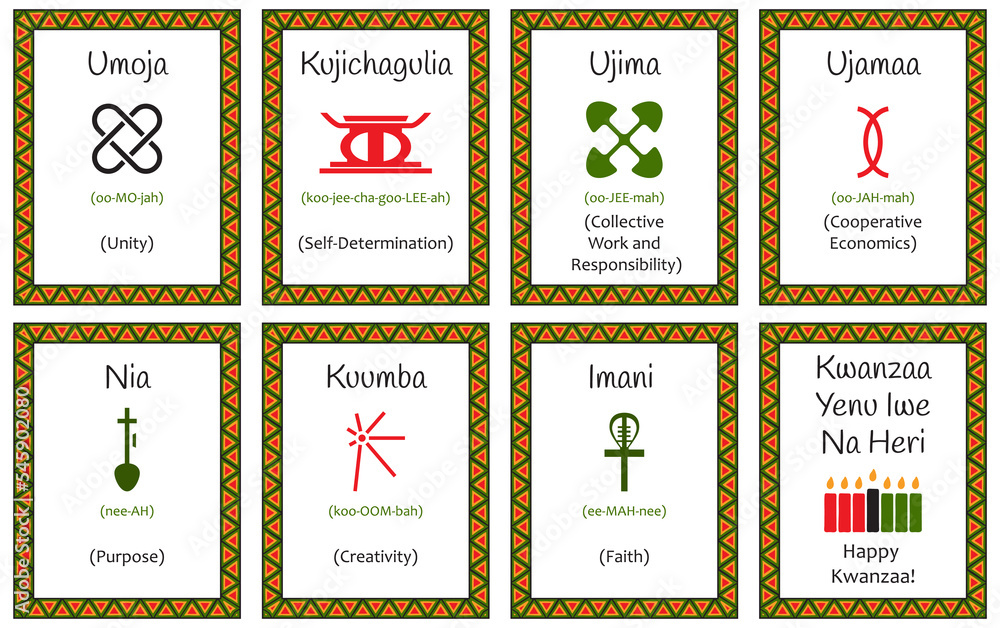The Celebration of Kwanzaa

Kwanzaa is a weeklong holiday celebration of African American culture held annually from December 26 to January 1, culminating in a communal feast.
This is not a religious holiday but a cultural celebration based on African harvest festival traditions and is a way to celebrate African heritage and legacy, much like other cultural celebrations.
Fundamentally, Kwanzaa celebrates family, culture, community, and the harvest during the dark days of winter. The word Kwanzaa comes from the Kiswahili phrase matunda ya kwanza, meaning “first fruits [of the harvest].”
The 7-day festival focuses on seven essential principles, known as the Nguzo Saba, each represented by 1 day of the 7-day celebration. These principles are:
- unity (umoja),
- self-determination (kujichagulia),
- collective work and responsibility (ujima),
- cooperative economics (ujamaa),
- purpose (nia),
- creativity (kuumba), and
- faith (imani).

The History of Kwanzaa
You may be surprised to learn that the modern holiday of Kwanzaa is a relatively new creation, though it has its roots in traditions that go back generations.
First celebrated in 1966, Kwanzaa is the brainchild of Dr. Maulana Karenga—an African American author, professor, and activist—to nurture the community and cultural spirit of African Americans.
While created with the traditional African harvest festivals in mind, Kwanzaa itself is uniquely North American, celebrated mainly in the United States, Canada, and the Caribbean.
AKWANSOSEM AFRICAN STUDIES PROGRAM - OUTREACH, UNIVERSITY OF WISCONSIN-MADISON Vol. III, No. 2 - March, 1990
This celebration is not a festival originating in any of the 55 African countries nor is it an “African” Christmas celebration. Kwanzaa is an African-Americans celebration of life from 26 December to 1 January.
Dr. Maulana Karenga introduced the festival in 1966 to the United States as a ritual to welcome the first harvests to the home. Dr. Karenga created this festival for Afro-Americans as a response to the commercialism of Christmas. In fact one might say that Kwanzaa has similarities with Thanksgiving in the United States or the Yam Festival in Ghana and Nigeria. The word “kwanza” is a KiSwahili (Kenya, Uganda, Tanzania) word meaning “first.”
Five common sets of values are central to the activities of the week: ingathering, reverence, commemoration, recommitment, and celebration. The seven principles (nguzo saba) of Kwanzaa utilize Kiswahili words: unity (umoja), self-determination (kujichagulia), collective work and responsibility (ujima), cooperative economics (ujamaa), purpose (nia), creativity (kuumba), and faith (imani). Each of the seven candles signify the principles. Like the Jewish Hannakah, candles are used to represent concepts of the holiday.
The symbols of Kwanzaa includes crops (mzao) which represents the historical roots of African-Americans in agriculture and also the reward for collective labor. The mat (mkeka) lays the foundation for self- actualization. The candle holder (kinara) reminds believers in the ancestral origins in one of 55 African countries. Corn/maize (muhindi) signifies children and the hope associated in the younger generation. Gifts (Zawadi) represent commitments of the parents for the children. The unity cup (Kkimbe cha Umoja) is used to pour libations to the ancestors. Finally, the seven candles (mishumaa saba) remind participants of the severl pinciples and the colors in flags of African liberation movements — 3 red, 1 black, and 3 green.
Gifts are exchanged. On 31 December participants celebrate with a banquet of food often cuisine from various African countries. Participants greet one another with “Habari gani” which is Kiswahili for “how are you/ how’s the news with you?” For further information about Kwanzaa, write to the University of Sankore Press, 2540 W. 54th St., Los Angeles, CA 90043. A children’s book about KWANSA by Deborah Newton Chocolate is available through Childrens’ Press, 1990, Chicago.












